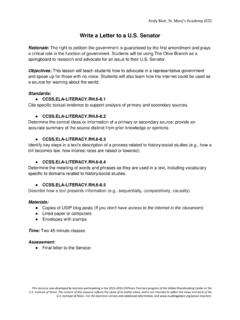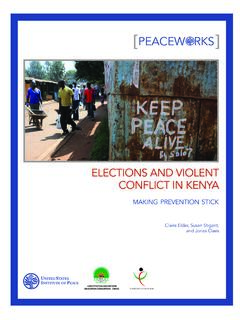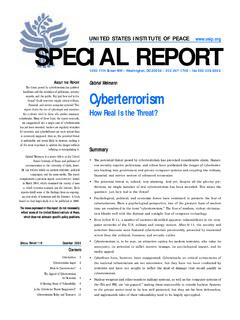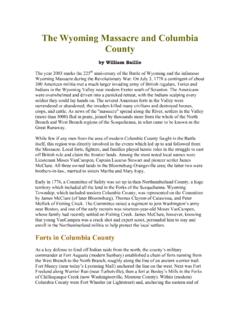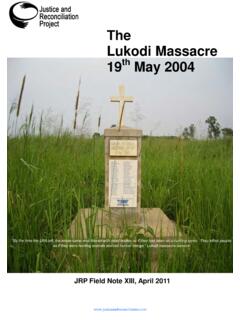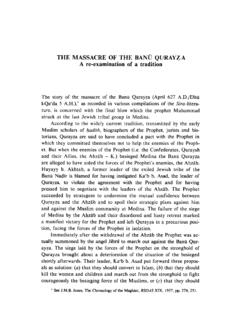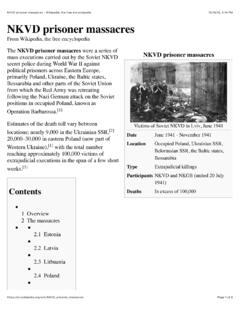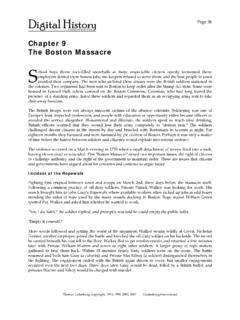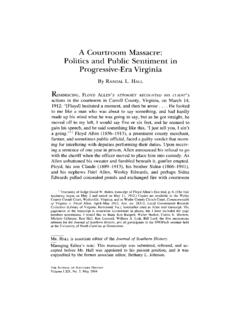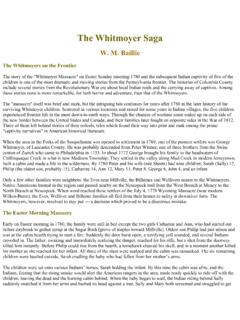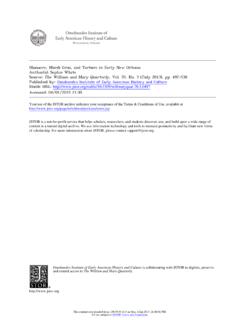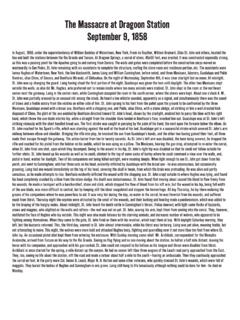Transcription of Reconciling Narratives of the Nanjing Massacre in Japanese ...
1 1 Reconciling Narratives of the Nanjing Massacre in Japanese and Chinese Textbooks Tsuru Bunka University Tokushi Kasahara I. One Chinese Student s Findings Recently, in a course I taught, there was a student from China who conducted a research project regarding the different ways that the Nanjing Massacre has been remembered in China and Japan. Although the quotation from her paper that I would like to read is long, I would like to share it here as it underscores a significant rift in remembrances in our two countries: I was born in 1983 and received an ordinary education. Many Chinese tend to associate the Nanjing Massacre with an image of mass execution, rape, and looting. To the Chinese, the Nanjing Massacre is not a scholarly issue, but an issue relating to ethnic identity and emotion. Chinese who receive an ordinary education learn that the Nanjing Massacre involved the slaughter of 300,000 people.
2 The Chinese public remembers it as an indisputable fact, just like the earth is round. When I came to Japan and discovered different views of the Nanjing Massacre , I was stunned, to put it frankly. The image of Nanjing that I had in mind since elementary school was challenged and I was confused. Whereas in China, the next generation studies a fixed account of Nanjing , the dispute over Nanjing continues in Japan. Because many scholars write contradictory studies of the Massacre , it seems apparent that young Japanese often get confused. Moreover, their interest in Nanjing is very low; all they know are terms such as Nanjing Massacre and Nanjing Incident without comprehending the details of the event. Since I came to Japan, I gradually came to realize that the general atmosphere surrounding scholarship on the Nanjing Massacre is quite different in Japan and China. Chinese have had a fixed perception of what happened in the Nanjing Massacre , and they do not allow Japanese to challenge it.
3 In contrast, Japanese think that Japan would be innocent if there had been no atrocities in Nanjing . If the Japanese were to tell the Chinese that the Nanjing Massacre is an illusion, fabrication, or Chinese propaganda, that would certainly infuriate them. In the Chinese public memory, the Nanjing Massacre and the killing of 300,000 people are indisputable truths. No denial or indecision is allowed in China when it comes to the Nanjing Massacre . Chinese students not only read in their textbooks about the atrocities committed against 300,000 people, but they also learn it as common knowledge. Thus, the question of whether the number of deaths was actually 300,000 or not attracts no attention among Chinese. In China, all of the citizens share a public memory that 300,000 people were slaughtered. In Japan, there are people who claim that the Nanjing Massacre was a lie, but those Japanese who do not acknowledge the Nanjing Massacre will be the object of opprobrium in China.
4 The differences in the ways the Chinese and Japanese publics have remembered Nanjing are major obstacle to reconciliation today, and historical education is one of the reasons for the rift. A simple look at the history textbooks used by both Japanese and Chinese students makes clear how different those public memories actually are. 2 II. Description of the Nanjing Massacre in Japanese and Chinese Textbooks (1) Japan In Japan, there are eight history textbooks that are used today in junior high schools. All textbooks use the words Nanjing Incident, Nanjing Massacre , or Nanjing Massacre Incident to describe the atrocities. The textbook published by the T ky Shoseki is the most widely adopted in Japan and currently holds a market share of In it, the passage about the Nanjing Massacre reads as follows. The Japanese military occupied the capital of Nanjing in the same year [1937].
5 In its process, [the military] killed a massive number of Chinese, including women and children. In contrast, the publisher Nihon Shoseki, specified the estimate of the casualties in Nanjing , stating, In late December [1937], the Japanese military captured the capital Nanjing . [The military] killed as many as 200,000 prisoners of war and civilians, and the atrocities and looting were not brought to an end; therefore, [Japan s capture of Nanjing ] received fierce international condemnation. Although Nihon Shoseki resisted pressure from the Ministry of Education, Culture, Sports, Science, and Technology (MEXT) to omit a specific figure for the death estimate, Nihon Shoseki was the only publisher among the eight that gave a specific number to quantify the atrocities in Nanjing . As conservative critics began to rally against the textbook, the market share of this book fell to a mere Unlike these two textbooks, Fus sha s textbook, written by the pro-Imperial revisionist organization called the Japanese Society for History Textbook Reform, avoided strong terms such as atrocity and stressed that the debate over Nanjing is on-going and that the historical facts are unclear.
6 They write, the Japanese military believed that Chiang Kai-shek would surrender if Nanjing were captured, and they conquered Nanjing in December. In the footnote, the publisher added, at this time, the Japanese military killed and wounded many Chinese soldiers and civilians (the Nanjing Incident). Moreover, various views and data exist regarding the historical facts, including the casualty estimate, and the debate continues to this day. Because citizens groups organized a successful campaign to prevent the textbook from being adopted by boards of education across Japan, its market share has ended up only around (2) China In 2001, the Ministry of Education of the People s Republic of China issued the Standard History Curriculum for Mandatory Education in Full-Time Schools. Based on the standards laid forth in this document, the Beijing Teachers College Press published a textbook called New Century: Standard History Textbook in Mandatory Education.
7 This book described the Nanjing Massacre as follows. The Nanjing Massacre : In December 1937, the Japanese military captured Nanjing . The Japanese military committed bloody atrocities against the residents of Nanjing and prisoners of war, killing them in extremely cruel methods including mass execution, burning, burying alive, beheading, and biting by dogs. The Nanjing Massacre was the most horrible [event] in world [history]. On December 16, the Japanese military escorted approximately 5,000 Chinese civilians and captured officers and soldiers from the Guest House for Overseas Chinese to the Zhongshan Pier. After turning machine guns against [these captives], [the Japanese military] threw the dead bodies into the Yangtze River and burned them. On the 18th, the Japanese military tied 57,000 people, regardless of age and gender, confined at Mufu Mountain, took them to the Caoxie Gorge at 3 Xiaguan, and killed them with machine guns.
8 Moreover, [the Japanese military] bayoneted a crowd struggling to survive in the sea of blood to death. Then, the Japanese military scattered kerosene, burned the dead bodies, and dumped bodies and bones in the Yangtze River. In addition, the Japanese Army competed with one another in an abnormal killing contest. Two Japanese lieutenants, Mukai Toshiaki and Noda Tsuyoshi, decided to see who could be the first to cut down one hundred Chinese by the time of the fall of Nanjing . By the time that these two murderers conducted an interview [with a Japanese newspaper correspondent] at the foot of Zijin Mountain with their blood-thirsty swords in hand, Noda had killed 105 people, while Mukai had killed 106. [No one knew] which one cut down one hundred people first, so the contest continued. They decided to judge the winner by cutting down one hundred and fifty. In December 1937, Japan s T ky Nichinichi Newspaper described the killing contest from the victor s viewpoint.
9 The Japanese military considered this [killing contest] as something that would enhance national glory and called it an honorable accomplishment. According to statistics, the estimate of the deaths caused by Japanese atrocities against unarmed Nanjing residents and Chinese soldiers amounted to more than 300,000 just during the six weeks of the occupation by the Japanese military. The Nanjing Massacre is one of the greatest acts of violence perpetrated by the Japanese aggressors on the Chinese people. The different descriptions of the Nanjing Massacre are reflected in different understandings of the atrocities. According to a survey of 221 Japanese college students and 524 Chinese college students conducted by the Chinese student mentioned above, all Chinese students answered yes and of the Japanese students answered yes to the question [Do you think that] the Nanjing Massacre occurred?
10 Of the Japanese students answered no, and stated don t know. In response to a question asking the students if the hundred-man killing contest took place, of the Chinese students said yes, while of the Japanese answered no. Among the Japanese students, responded that they had no idea. As to the estimate of the victims in Nanjing , of the Chinese students and of the Japanese students answered 300,000, whereas of the Chinese and of the Japanese chose 200,000. Those who answered don t know accounted for of the Chinese students and of the Japanese students. As the survey found, many Japanese believe that the Nanjing Massacre occurred. This is surely understandable because almost all elementary school Japanese history textbooks, all high school Japanese history textbooks, and almost all high school world history textbooks include mention, however fleeting, of the Nanjing Incident, Nanjing Massacre , and Nanjing Atrocities.




